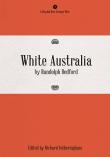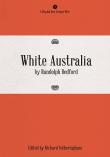
Latest Issues
AbstractHistoryArchive Description
Melodrama.
Billed as a 'patriotic drama,' White Australia tells of an attempted invasion by Japan, with help from some Northern Territory Aborigines and a white traitor, which is thwarted by a Northern Territory squatter.
The first two acts deal with the descent of Japanese troops on Port Darwin, together with the spying and treachery of their leading officer, Yamamoto. The opening scene is set on the station owned by Geoffrey Pearse, the squatter who has invented and is currently building an airship capable of carrying enough explosives to destroy an invading navy. Although rumours about dissent among Japanese workers on the coast have begun to circulate, they are not taken seriously by those on the station or around the district. An enthusiastic toast to Australia is followed shortly afterwards, however, by new rumours of outright warfare and a spirited fight outside the station house as tension mounts. The drama then shifts to the centre of the continent and where two telegraph workers sit in their hut discussing the year Malua won the cup while their mate goes about his work outside unaware that death is creeping up behind him in the shape of a coloured man. The second act is set in Port Darwin, where the airship's project manager and chief engineer Jack Macquarie and his sweetheart, 'a more than usually reckless heroine' are involved in a situation inside an opium house. When Macquarie carelessly loses the cryptic key which allows the airship's delicate machinery to work, the Japanese spy leader gains possession of it. Meanwhile the land invasion continues, with this act culminating in the defence of Port Darwin. As the streets are swept by machine gun fire defenders and assailants fall in heaps. 'Among the slain being one of the cheerful young Australian girls... whom the author does not hesitate to sacrifice in his fine frenzy for the flag' (Age 28 June 1909, p9).
Although the Yamamoto now has the key he does not have the password that makes it effective. Knowing that if he fails to get the information the Japanese fleet will very likely be destroyed, he captures and tortures the young engineer inventor. Macquarie refuses to divulge the password, however, and Yamamoto subsequently orders his sweetheart to also be tortured. She is then given to Geoffrey Pearse's nephew, the traitorous and degenerate Cedric, to be 'outraged' (Table Talk 1 July 1909, p24).
In the remaining two acts Bedford threads together his incidents in a manner which the Age describes has little regard for ordered sequence. In the critic's opinion it is not Bedford's invention, but rather 'his arrangement that is at fault.'
One of the feature incidents reported by the paper's theatre critic was the sensation scene in which Macquarie's airship travels at an indefinite height through clouds above Sydney while 'hurling missiles of destruction upon the enemy's fleet' (Age 28 June 1909, p9).
The Age's review of the King's Theatre production suggests that Bedford had bestowed much thought in developing the important character of Yamamoto. 'This man,' writes the critic, 'is really the crown and centrepiece of the elaborate scheme that has evolved for the capture of Australia. The character is in no sense burlesqued; in fact he possess all the brains and resources that Mr Bedford would presumably bestow upon a clever white man, while the Japanese possess a devotion to national duty that the white man in these latitudes does not often recognise' (Age 28 June 1909, p9).
The comedic elements in the play were largely provided in the King's Theatre season by Bert Bailey in the role of Aboriginal tracker, Terrabit, and Temple Harrison, as a comic swagman with a memory of Sir 'Enery Parkes. Other leading characters were Bill Pearse '(Walter Dalgleish), as the one-time drunken young Australian who rises finely to a crisis;' his cousin Cedric Pearse (Lawrence Dunbar) the villain who sides with the enemy; and Jim Tennant (Max Clifton) as 'a stockman who becomes warlike when the enemy's guns are heard' (Age 28 June 1909, p9).
Notes
-
The Age theatre critic writes of the Melbourne premiere : 'As its name implies, [White Australia] is intensely Australian. It strikes the note of local patriotism and strikes it with greater emphasis, probably, than any piece staged in this country has yet done. Another feature of Mr Bedford's work, and a very admirable one, is its originality. he has written melodrama, but it is melodrama with a difference. He has got right away from the beaten track. Most of the stock figures and all stereotypical situations have been thrown overboard. There is no hero struggling under wrongful accusations, no heavy parent protesting that a son or daughter is "no longer a child of mine," no ancestral English home plunged into sudden gloom. There is none of the verbiage with which every playgoer is familiar. The author treats of a new theme - an actual invasion of Australia by a confederation of coloured races - and he brings new materials, new situations and new people before the footlights. All this is to his credit. had he paid more attention to coherency of plot and to the laws of probability he would have done better still. As it is, his drama stands out a thing of shreds and patches - vivid and startling patches some of them, but not necessarily in harmony one with the other' (28 June 1909, p9).
-
The Age reviewer saw the play in a rather different light, being especially concerned at what he or she saw as controversial and politically insensitive subject matter. 'Aimed directly against a nation with which we are at peace, and which is, moreover, Britain's ally,' writes the critic, 'this is surely somewhat "out of bounds." The English censor of plays would not permit of the invaders in Major du Maurier's drama representing any particular nation, and the foreign army, as reconsidered, served the nebulous "Empress of the North." However, the Australian sensationalist dramatist, like the sapper, can carve his way to fame without the necessity of holding anything sacred en route, and with Habakuk is "capable of everything"' (28 June 1909, p9).
The same review also calls into question Bedford's dramatic organisation, noting that although the story was a simple and direct one the playwright had 'surrounded [it] with a multiplicity of detail that at times clouds instead of helping, the issue; [and that] in fact Mr Bedford has given the playgoer a plethora of riches that he finds it hard to digest. Many of them can be put on one side altogether, and others - notably the two torture scenes - reduced to a minimum. This done, and some of the jingoistic Australian speeches subdued, the drama will knit, play closer, and rise without hindrance to the final catastrophe' (28 June 1909, 9).
-
Two songs were performed during the play : 'Mine, For Ever Mine' (sung by Margherita Bedford) and 'Australia, My Beloved Land' (sung by C. A. Ledward).
-
Randolph Bedford's daughter, Margherita, played the part of Mary Bannister in the King's Theatre production.
Production Details
-
1909 : Protestant Hall, Melbourne ; 27 February.
1909 : King's Theatre, Melbourne ; 6-25 June. Dir. J. H. Nunn; Prod. William Anderson (q.v.) ; Scenic Art Rege Robins ; Music Dir. George Sutch. - Cast incl. Roy Redgrave (q.v., Jack Macquarie), Edmund Duggan (q.v., Geoffrey Pearse, of Arafura and Marandana), Laurence Dunbar (Cedric Pearse, his nephew), Walter Dalgleish (Bill Pearse, his son), Harry Diver (Yamamoto, a servant to Cedric and a spy), Stirling Whyte (Mat Flinders, a telegraph operator on the Overland), Temple Harrison (Gamaliel Webster, a swagman), Max Clifton (Jim Tennant, a stockman), Bert Bailey (q.v., Terribit, a tracker), G. McKenzie (Sam Palmer, buffalo hunter), J. H. Nunn (Quong Ping, a Port Darwin Chinatown merchant), Frank Rosemore (Hop Lee, a hawker), Fred Kehoe (Australian Officer), J. F. Rodgers (Oyama, a cook at Marandana Station), Frank Slade (Japanese Officer), Helen Vigours (Victoria Pearse, heiress of Marandana), Kate Gair (Kate Carlton, her companion), Blanche Clements (Lota, Yamamoto's sister), Lilly Bryer (Pawpaw Sal, of Darwin), Margherita Bedford (Mary Bannister, daughter of the resident), Fanny Erris (Minimie, Terrabit's gin), Kathleen Lorrimer (Mrs Washer, of the Sydney Rocks), Maudie Cosham (Pipinee, a gin).
-
This entry has been sourced from on-going historical research into Australian popular theatre being conducted by Dr Clay Djubal.
Publication Details of Only Known VersionEarliest 2 Known Versions of
Works about this Work
-
y
 Australia on the Popular Stage 1829-1929
Melbourne
:
Oxford University Press
,
1983
Z922827
1983
selected work
Australia on the Popular Stage 1829-1929
Melbourne
:
Oxford University Press
,
1983
Z922827
1983
selected work
-
King's Theatre
1909
single work
review
— Appears in: Table Talk , 15 July 1909; (p. 24)
— Review of White Australia, or, The Empty North 1909 single work drama -
King's Theatre : 'White Australia'
1909
single work
review
— Appears in: Table Talk , 1 July 1909; (p. 24)
— Review of White Australia, or, The Empty North 1909 single work drama -
Kings' Theatre : 'White Australia, Or, The Empty North'
1909
single work
review
— Appears in: The Argus , 28 June 1909; (p. 9)
— Review of White Australia, or, The Empty North 1909 single work drama -
The King's Theatre - A 'White Australia'
1909
single work
review
— Appears in: The Age , 28 June 1909; (p. 0)
— Review of White Australia, or, The Empty North 1909 single work drama
-
The King's Theatre - A 'White Australia'
1909
single work
review
— Appears in: The Age , 28 June 1909; (p. 0)
— Review of White Australia, or, The Empty North 1909 single work drama -
Kings' Theatre : 'White Australia, Or, The Empty North'
1909
single work
review
— Appears in: The Argus , 28 June 1909; (p. 9)
— Review of White Australia, or, The Empty North 1909 single work drama -
King's Theatre : 'White Australia'
1909
single work
review
— Appears in: Table Talk , 1 July 1909; (p. 24)
— Review of White Australia, or, The Empty North 1909 single work drama -
King's Theatre
1909
single work
review
— Appears in: Table Talk , 15 July 1909; (p. 24)
— Review of White Australia, or, The Empty North 1909 single work drama -
y
 Australia on the Popular Stage 1829-1929
Melbourne
:
Oxford University Press
,
1983
Z922827
1983
selected work
Australia on the Popular Stage 1829-1929
Melbourne
:
Oxford University Press
,
1983
Z922827
1983
selected work
-
cAustralia,c
- Sydney, New South Wales,
- Northern Territory,



